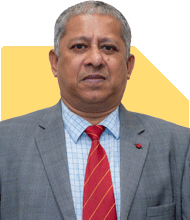Ramalingam Kalirajan |9699 Answers |Ask -Follow
Mutual Funds, Financial Planning Expert - Answered on Jun 20, 2025
He has an MBA in finance from the University of Madras and is a certified financial planner.
He is the director and chief financial planner at Holistic Investment, a Chennai-based firm that offers financial planning and wealth management advice.... more

I am 30 and 2 month ago I started SIP 1000 Motilal and 1k Aditya Birla also 15k lumsum in Aditya Birla.so can you please suggest it's ok or what else for good returns.... Thanku
Taking action is always the first step.
You have made a strong beginning.
Let us now assess your investments in detail.
Then we will explore better ways to grow your wealth.
Review of Your Current Investment
You have:
SIP of Rs.1000 in one Motilal fund
SIP of Rs.1000 in one Aditya Birla fund
Lump sum of Rs.15,000 in another Aditya Birla fund
This means your total monthly SIP is Rs.2,000
And Rs.15,000 is invested as one-time lump sum.
You have chosen well-known fund houses.
That is a good starting point.
But fund house alone is not enough to judge performance.
We must check the fund type, suitability, and your goal.
Are Your Investments Enough?
Let us assess whether your current setup is sufficient.
You are 30 years old now.
Your investment horizon is long.
So your portfolio should be designed for growth.
But investing Rs.2000 monthly is not enough for future goals.
Rs.15,000 lump sum is also small for long-term wealth creation.
If your income allows, you must increase monthly SIP.
Common Mistakes to Avoid at This Stage
It is good to avoid certain mistakes early.
Here are a few you should be aware of:
Don’t chase returns blindly
Don’t invest without a goal
Don’t invest based on ads or social media
Don’t put all money in same AMC
Don’t ignore portfolio reviews
Don’t continue low-performing funds for long
Many new investors fall into these traps.
Being careful now saves trouble later.
Importance of Goal-Based Investing
You must invest with a purpose.
Without a goal, your investment lacks direction.
Some common goals:
Retirement
Buying a house (but not real estate as investment)
Child’s education or marriage
Starting own business later
Financial independence by 50
Once you define goals, your fund choice becomes clear.
Each goal should have a separate strategy.
This gives better clarity and control.
Limitations of Current Portfolio Structure
From your shared info, your portfolio has:
Two SIPs
One lump sum
All in equity funds
This is good for growth, but not enough by itself.
A complete plan needs:
Clear goal-based buckets
Asset allocation (equity + debt)
Review every year
Exit strategy before goal maturity
More Points to Consider for Strong Returns
To increase return potential:
You need proper diversification
SIP amount should rise every year
Fund selection should be through a Certified Financial Planner
You should avoid direct funds if you are investing without guidance
Direct plans don’t suit investors without expert support.
Direct funds offer no personalised review.
You don’t get behavioural coaching or handholding.
In long term, this leads to bad fund switches.
Or panic selling during market falls.
Better to go with regular funds through MFD with CFP credentials.
What Type of Funds Should You Consider?
You didn’t mention fund category (like large cap, hybrid, etc.)
Just AMC name is not enough.
But here are some suggestions for your stage of life:
Multi-cap or flexi-cap funds are good for starting
Balanced advantage funds help in managing volatility
Mid-cap can be added once SIP base is stronger
Avoid sectoral or thematic funds right now
Choose active funds, not index funds or ETFs
Why to Avoid Index Funds
Many think index funds are low-cost and easy.
But they also have many issues:
No chance of outperformance
They copy market ups and downs
No risk management by fund manager
No option to shift strategy based on situation
Instead, actively managed funds offer:
Professional decision-making
Better returns potential
Flexibility in market phases
Quality stock selection
A Certified Financial Planner helps you choose the right ones.
SIP Strategy for Long-Term Success
You are just two months into your SIP journey.
That is a great first step.
But to build strong returns:
Increase SIP to Rs.5000 as soon as income allows
Review SIPs yearly
Add new funds based on changing life goals
Avoid pausing SIPs during market fall
Link SIPs to specific goals like retirement or future expenses
Also consider step-up SIP.
Increase SIP by Rs.500 or Rs.1000 every year.
This helps your corpus grow faster.
Role of Lump Sum Investments
You invested Rs.15,000 lump sum.
That’s a good start.
But for lump sum, timing matters more.
Don’t invest lump sum in only one fund
Spread across 2–3 funds to reduce risk
Use STP from liquid fund to equity fund if amount is big
Use lump sum only when market gives correction
Better results come when lump sum is planned wisely.
Keep Monitoring Your Progress
Tracking investment performance is important.
If fund is underperforming for 2+ years, consider switching.
Don’t switch early based on short-term returns.
Do portfolio review every year with a Certified Financial Planner.
Review should cover:
Performance
Alignment with goals
Tax impact
Rebalancing need
Tax Planning for SIP and Lump Sum
Your equity mutual fund gains will be taxed as follows:
LTCG above Rs.1.25 lakh taxed at 12.5%
STCG taxed at 20%
So, keep eye on tax while redeeming.
Plan redemptions as per tax rules and goal timing.
Debt fund gains are taxed as per your tax slab.
This matters if you add hybrid or debt funds later.
Your Certified Financial Planner can help structure exit tax-efficiently.
What You Can Do Next
Here is what you should now focus on:
Increase monthly SIP to minimum Rs.5000
Split SIP across 2–3 fund categories
Build emergency fund of 3–6 months expenses
Buy term insurance if not yet done
Avoid insurance-cum-investment plans like ULIP or LIC for returns
Review your portfolio every year with professional help
If you have any LIC or ULIP, do surrender and reinvest in mutual funds.
They give low return and poor flexibility.
Finally
Starting early is your biggest strength.
You have made a promising beginning.
Now your focus must shift to structure, growth, and consistency.
Mutual funds are great for long-term goals.
But they need strategy and regular review.
Avoid direct funds and index funds unless guided by a professional.
Go with regular plans and a Certified Financial Planner for better tracking.
Your portfolio needs clear direction, proper risk control, and yearly review.
By doing this, you can build strong wealth in next 15–20 years.
Let your investments support your dreams, not just generate returns.
Money grows best when guided with purpose and wisdom.
Best Regards,
K. Ramalingam, MBA, CFP,
Chief Financial Planner,
www.holisticinvestment.in
https://www.youtube.com/@HolisticInvestment
You may like to see similar questions and answers below
Omkeshwar Singh | Answer |Ask -Follow
Head, Rank MF - Answered on May 13, 2022
Ramalingam Kalirajan |9699 Answers |Ask -Follow
Mutual Funds, Financial Planning Expert - Answered on Apr 27, 2024
Ramalingam Kalirajan |9699 Answers |Ask -Follow
Mutual Funds, Financial Planning Expert - Answered on Jul 19, 2024
Ramalingam Kalirajan |9699 Answers |Ask -Follow
Mutual Funds, Financial Planning Expert - Answered on Oct 24, 2024
Ramalingam Kalirajan |9699 Answers |Ask -Follow
Mutual Funds, Financial Planning Expert - Answered on Jan 16, 2025
Prof Suvasish Mukhopadhyay |2568 Answers |Ask -Follow
Career Counsellor - Answered on Jul 12, 2025
Prof Suvasish Mukhopadhyay |2568 Answers |Ask -Follow
Career Counsellor - Answered on Jul 12, 2025
Prof Suvasish Mukhopadhyay |2568 Answers |Ask -Follow
Career Counsellor - Answered on Jul 12, 2025
Prof Suvasish Mukhopadhyay |2568 Answers |Ask -Follow
Career Counsellor - Answered on Jul 12, 2025
Prof Suvasish Mukhopadhyay |2568 Answers |Ask -Follow
Career Counsellor - Answered on Jul 12, 2025
Prof Suvasish Mukhopadhyay |2568 Answers |Ask -Follow
Career Counsellor - Answered on Jul 12, 2025
Prof Suvasish Mukhopadhyay |2568 Answers |Ask -Follow
Career Counsellor - Answered on Jul 12, 2025
Prof Suvasish Mukhopadhyay |2568 Answers |Ask -Follow
Career Counsellor - Answered on Jul 12, 2025
Prof Suvasish Mukhopadhyay |2568 Answers |Ask -Follow
Career Counsellor - Answered on Jul 12, 2025
Prof Suvasish Mukhopadhyay |2568 Answers |Ask -Follow
Career Counsellor - Answered on Jul 12, 2025



















